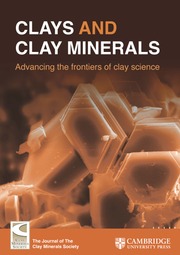Article contents
Copper(II) Interactions with Kaolinite: Factors Controlling Adsorption
Published online by Cambridge University Press: 01 July 2024
Abstract
The adsorption of Cu2+ on kaolinite was studied at different ionic strengths following various treatments of the mineral surface in order to evaluate the conditions influencing adsorption. The data indicate a strong preference of the Na+ exchange form of kaolinite for Cu2+ but a weak affinity of the natural kaolinite for Cu2+. Protons are generated by Cu2+ adsorption, a result of the exchange of surface protons, and possibly the enhancement of Cu2+ hydrolysis at the kaolinite surfaces. The exchange of Na+ by Cu2+ on the kaolinite is not described by the mass-action equation, but can be interpreted in terms of permanent charge sites on the surfaces when the additional factors of Na+-H3O+ exchange and blockage of sites by Al ions are considered.
Резюме
Изучалась абсорбция Cu2+ каолинитом при различной ионной силе, обусловленной разнообразными обработками поверхности минерала, проведенными, чтобы определить условия, влияющие на абсорбцию. Полученные данные показывают сильную способность Na+ обменной формы каолинита к обмену на Ca2+, но слабую способность к обмену на Cu2+ естественного каолинита. Протоны генерируются в результате абсорбции Cu2+ как результат обмена поверхностных протонов и возможно увеличения гидролиза Cu2+ на поверхностях каолинита. Обмен в каолините Na+ на Cu2+ не описывается уравнением действия масс, а может интерпретироваться как места постоянных зарядов на поверхностях, если рассматривать дополнительные факторы обмена Na+-H3O+ и блокирование этих мест ионами Al.
Kurzreferat
Um die Bedingungen unter welchen Adsorption stattfindet, zu finden, wurde, nach etlichen Behandlungen der Mineraloberfläche, die Adsorption von Cu(II) an Kaolinit bei verschiedenen Ionenstärken gemessen. Die Messdaten bringen eine starke Bevorzugung der Na+Austauschform des Kaoliniten für Cu(II) hervor, aber nur eine schwache Affinität des natürlichen Kaoliniten für Cu(II). Protonen werden durch die Cu(II) Adsorption erzeugt, ein Resultat des Austausches von Protonen an der Oberfläche, und vielleicht eine Zunahme von Cu(II) Hydrolyse an den Kaolinitoberflächen. Der Austausch von Na durch Cu Ionen am Kaolinit kann nicht mit der Massen-Aktionsgleichung beschrieben werden, aber er kann als permanente Ladungsstellen an den Oberflächen interpretiert werden, falls die zusätzlichen Faktoren des Na+-H3O+ Austausches und Blockierung der Stellen durch Al Ionen in Betracht gezogen werden.
Information
- Type
- Research Article
- Information
- Copyright
- Copyright © 1978, The Clay Minerals Society
References
- 37
- Cited by

